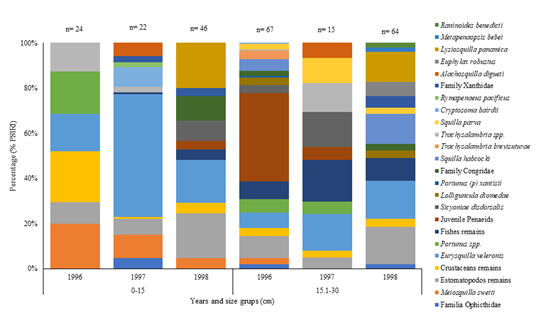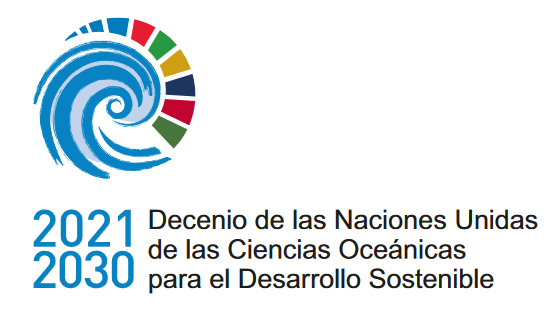Alimentación de los lenguados Cyclopsetta querna y Syacium latifrons en la costa de Jalisco y Colima, México
DOI:
https://doi.org/10.47193/mafis.3512022010110Palabras clave:
Peces planos, trofodinámica, plataforma continental, Pacífico Este tropicalResumen
Los lenguados forman un componente importante como fauna de acompañamiento del camarón. El objetivo del presente trabajo consistió en analizar la alimentación de Cyclopseta querna y Syacium latifrons, con el fin de ampliar el conocimiento biológico de estas especies. Los ejemplares se colectaron en siete estaciones de muestreo con redes de arrastre de camarón. Se analizaron los estómagos de 196 individuos de C. querna y 313 de S. latifrons. El espectro trófico de C. querna estuvo constituido por 12 componentes alimentarios, mientras que para S. latifrons se registraron 24. Las presas principales de C. querna fueron los peces, mientras que para S. latifrons fueron los crustáceos, como por ejemplo, estomatópodos. Se observó una ligera variación ontogénica en la dieta de C. querna, no así en S. latifrons; sin embargo, en la dieta por sexos no se observaron diferencias. Los análisis de diversidad del espectro alimentario fueron menores de 0,5 para ambas especies. Se considera que en ambas especies la alimentación se da principalmente por la disponibilidad de recursos en las estaciones del año y por la capacidad de captura de presas. Por otra parte, la coexistencia de estas especies en una misma zona se da por diferencias en el consumo preferencial de sus presas al disminuir la competencia por alimento.
Descargas
Referencias
Aarnio K, Bonsdorff E, Rosenback N. 1996. Food and feeding habits of juvenile flounder Platichthys flesus and turbot Scophthalmus maximus in the Aland Archipelago, Northern Baltic Sea. J Sea Res. 36 (3/4): 311-320.
Aceves-Medina G, Saldierna-Martínez JR, González EA. 2003. Distribution and abundance of Syacium ovale larvae (Pleuronectiformes: Paralichthyidae) in the Gulf of California. Rev Biol Trop. 51 (2): 561-570.
Allen GR, Robertson DR. 1994. Fishes of the tropical eastern Pacific. Honolulu: University of Hawaii Press. 332 p.
Alonso MK, Crespob EA, García NA, Pedraza SN, Mariottic PA, Morac NJ. 2002. Fishery and ontogenetic driven changes in the diet of the spiny dogfish. Squalus acanthias, in Patagonian waters, Argentina. Environ Biol Fishes. 63:193-202.
Amezcua F, Portillo A. 2010. Hábitos alimenticios del lenguado panámico Cyclopsetta panamensis (Paralichthyidae) en el sureste del Golfo de California. Rev Biol Mar Oceanogr. 45 (2): 335-340.
Amezcua F, Portillo A, Amezcua Linares F. 2011. Feeding habits of the toothed flounder Cyclopsetta querna (Paralichthyidae) of the southeast Gulf of California. J Mar Biol Assoc UK. 91: 1225-1230.
Anuario Estadístico de Acuacultura y Pesca. 2018. Comisión Nacional de Acuacultura y Pesca (CONAPESCA). Mazatlán, Sinaloa, México. 293 p.
Bocanegra-Castillo N, Abitia Cardénas LA, Gálvan Magaña F. 2000. Espectro alimentario de la berrugata californiana Menticirrhus undulatus de Laguna Ojo de Liebre, baja California Sur, México. Cienc Mar. 26 (4): 659-675.
Brown SC, Bizzarro JJ, Cailliet GM, Ebert DA. 2012. Breaking with tradition: redefining measures for diet description with a case study of the Aleutian skate Bathyraja aleuca (Gilbert 1896). Environ Biol Fishes. 95 (1): 3-20.
Brusca RC. 1980. Common intertidal invertebrates of the Gulf of California. 2da ed. Tucson: University of Arizona Press. 153 p.
Burke JS. 1995. Role of feeding and prey distribution of summer and southern flounders in selection of estuarine nursery habitats. J Fish Biol. 47: 355-366.
Cabral HN, Lopes M, Loeper R. 2002. Trophic niche overlap between flatfishes in a nursery area on the Portuguese coast. Sci Mar. 66 (3): 293-300.
Colwell RK. 2019. EstimaS: Statistical estimation of species richness and shared species from simples. Version S9.1.0. [consultado 10 febrero]. http://viceroy.eeb.uconn.edu/estimates/.
Daniel WW. 1997. Bioestadística. Base para el análisis de las ciencias de la salud. 4ta ed. Ciudad de México: Limusa. 878 p.
Darnaude AM, Harmelin Vivien ML, Salen Picard C. 2001. Food portioning among flatfish (Pisces: Pleuronectiforms) juveniles in a Mediterranean coastal shallow area. J Mar Biol Assoc UK. 81: 119-127.
De Raedemaecker F, O’Connor I, Brophy D, Black A. 2011. Macrobenthic prey availability and the potential for food competition between 0-year group Pleuronectes platessa and Limanda limanda. J Fish Biol. 79: 1918-1939.
Figueiredo M, Morato T, Barreiros JP, Alfonso P, Santos RS. 2005. Feeding ecology of the White seabream, Diplodussargus, and the ballan wrasse, Labrusbergylta, in the Azores. Fish Res. 75: 107-119.
Flores Ortega JR, Godínez Domínguez E, González Sansón G, Rojo Vázquez JA, López Prado AC, Morales Jauregui MY. 2013. Abundancia, distribución, hábitos alimentarios e interacciones tróficas de cinco especies de lenguados (Pleuronectiformes) en el Pacífico central mexicano. Lat Am J Aquat Res. 41 (3): 423-439.
Fischer W, Krupp F, Schneider W, Sommer C, Carpenter KE, Niem VH. 1995. Guía FAO para la identificación de especies para los fines de la pesca, Pacífico Centro-Oriental. Vertebrados. Parte I. Vol. II. Roma: FAO. p. 647-1200.
Gerking SD. 1994. Feeding ecology of fish. First edition. Nueva York: Academic Press. 416 p.
Gibson RN. 1994. Impact of habitat quality and quantity on the recruitment of juvenile flatfishes. J Sea Res. 32: 191-206.
Hendrickx ME. 1995a. Camarones. En: Fischer W, Krupp F, Schneider W, Sommer C, Carpenter KE, Niem VH, editores. Guía FAO para la identificación de especies para los fines de la pesca. Pacífico Centro-Oriental. Vol. I. Roma: FAO. p. 417-537.
Hendrickx ME. 1995b. Cangrejos. En: Fischer W, Krupp F, Schneider W, Sommer C, Carpenter KE, Niem VH, editores. Guía FAO para la identificación de especies para los fines de la pesca. Pacífico Centro-Oriental. Vol. I. Roma: FAO. p. 565-636.
Hendrickx ME, Salgado-Barragán J. 1991. Los estomatópodos (Crustacea: Hoplocarida) del Pacífico mexicano. Inst Cienc del Mar y Limnol, Univ Nal Autón México, Publ Esp. 10: 1-200.
Hespenheiden HA. 1975. Ecología de los productores primarios en la Laguna de Celestúm, México. Patrones de variación espacial y temporal [tesis doctoral]. Universidad de Barcelona. 233 p.
Horn HS. 1966. Measurement of overlap in comparative ecological studies. Amer Naturalist. 100: 419-424.
Khidir KT, Chapleau F, Renaud CB. 2005. Phylogenetic relationships of Cyclopsetta and Syacium (Pleuronectiformes: Paralichthyidae). Cybium. 29 (4): 321-326.
Kouamelan PE, Teugels GG, Gourene G, Van der Audenaerde DFET, Ollevier F. 2000. Feeding habits of Mormyrops anguilloides (Mormyridae) in lacustrine and riverine habitats of a West African basin. Cybium. 24 (1): 67-79.
Krebs CJ. 1989. Ecological methodology. Nueva York: Harper and Row. 550 p.
Lagler KF, Bardach JE, Miller RR, May Passino DR. 1984. Ictiología. 1ra ed. Ciudad de México: AGT Editor. 489 p.
Lasiak T, McLachlan A. 1987. Opportunistic utilization of mysid shoals by surf-zone teleosted. Mar Ecol Prog Ser. 37: 1-7.
Lauzanne L. 1975. Régime alimentaire d’Hidrocyon forskali (Pisces: Characidae) dans le lac Tchad et ses tributaires. Cahiers ORSTOM, Série Hydrobiologie. 9 (2): 105-121.
Levins R. 1968. Evolution in changing environments. Some theoretical explorations. Princeton: Princeton University Press. 123 p.
López Carzola A, Forte S. 2005. Food and feeding habits of flounder Paralicthys orbignyanus (Jenyns, 1842) in Bahia Blanca estuary, Argentina. Hydrobiología. 549: 25-257.
López Martínez J, Herrera Valdivia E, Rodríguez Romero J, Hernández Vázquez S. 2010. Peces de la fauna de acompañamiento en la pesca industrial de camarón en el Golfo de California, México. Int J Trop Biol. 58 (3): 925-942.
Ludwing JA, Reynolds JF. 1988. Statistical ecology: a primer on methods and computing. Nueva York: Wiley-Interscience Publication. 337 p.
Magurran AE. 2004. Ecological diversity and its measurement. Nueva Jersey: Princeton University Press. 179 p.
Matallanas J. 1982. Estudio del régimen alimentario de Lampanyctus crodilus (Risso, 1810) (Pisces, Myctophidae) en las costas catalanas (Med. Occid.). Téthys. 10: 254-260.
Mariscal Romero J, Aguilar Palomino B, Lucano Ramírez G, Raymundo Huizar AR, Rodríguez Ibarra LE, Ruíz Ramírez S, González Sansón G. 1998. Asociaciones de peces demersales de la plataforma continental de Colima y Jalisco, México (primavera, 1995). Cienc Mar. 24 (1): 35-54.
Marques JF, Teixeira CM, Pinheiro A, Peschke K, Cabral HN. 2009. A multivariate approach to the feeding ecology of the channel flounder Syacium micrurum (Pisces: Pleuronectiformes), in Cape Verde. Eastern Atlantic. Cienc Mar. 35 (1): 15-27.
Morisita M. 1959. Measuring interspecific association and similarity between communities. Memoirs of the Faculty of Science. Kyushu University Series E (Biology). 3: 65-80.
Murakami T, Amaoka K. 1992. Review of the genus Syacium (Paralichthydae) with the description of a new species from Ecuador and Colombia. Bull Fac Fish Hokkaido Univ. 43 (2): 61-95.
Nelson JS. 2006. Fishes of the world. Fourth edition. Hoboken, Nueva Jersey: John Wiley & Sons. 601 p.
Nikolsky G. 1963. The ecology of fishes. Londres: Academic Press. 352 p.
Norbis W, Galli O. 2004. Hábitos de alimentación del lenguado Paralichthys orbignyanus (Valenciennes, 1842) en una laguna costera somera del Atlántico Sur: Rocha, Uruguay. Cienc Mar. 30 (4): 619-626.
Patell ME, Potter IC. 1998. Distributions, size compositions and diets of two abundant benthic ambush-feeding teleosts in coastal waters of south-western Australia. J Mar Biol Assoc UK. 78: 587-608.
Pérez Farfante I, Kensley B. 1997. Penaeoid and Sergestotoid shrimps and prawns of the world. Keys and diagnoses for the families and genera. Paris: Memoires du Museum National d’Histoire Naturelle. 175: 1-13.
Pinkas L, Oliphant MS, Iverson LK. 1971. Food habitats of albacore, bluefin tuna, and bonito in California waters. Calif Fish Game, Fish Bull. 152: 1-105.
Rathbun MJ. 1930. The cancroid crabs of America of the families Eurylidae, Portunidae, Atelecyclidae, Cangridae and Xanthidae. Bulletin of the United States. National Museum, (152): 1-229.
Raymundo Huizar AR, Saucedo Lozano M. 2008. Hábitos alimentarios del pez triglido Prionotus ruscarius (Gilbert & Starks, 1904) durante 1996, en las costas de Jalisco y Colima, México. Rev Biol Mar Oceanogr. 43 (1): 7-15.
Rodiles-Hernández R, González Díaz AA. Chan Sala C. 2005. Lista de peces continentales de Chiapas, México. Hidrobiológica. 15 (2): 245-253.
Rodríguez Ibarra LE. 2006. Distribución y abundancia de los lenguados en la plataforma continental de Jalisco y Colima, México (1995-1996). En: Jiménez Quiroz MDC, Espino Barr E, editores. Los recursos pesqueros y acuícolas de Jalisco, Colima y Michoacán. Guadalajara: Instituto Nacional de la Pesca, SAGARPA. p. 196-208.
Rodríguez Romero J, Palacios Salgado DS, López Martínez J, Hernández Vázquez S, Ponce Díaz G. 2008. Composición taxonómica y relaciones zoogeográficas de los peces demersales de la costa occidental de Baja California Sur, México. Rev Biol Trop. 56 (4): 1765-1783.
Rojas MPA, Zapata PLA. 2006. Peces demersales del parque Nacional Natural Gorgona y su área de influencia, Pacífico colombiano. Biota Colombiana. 7 (2): 211-244.
Rosecchi E, Novaze Y. 1987. Comparaison de cinq índices alimentaires utilisés dans y’ analyse des contenus stomacaux. Rev Trav Inst Pêches Marit. 49 (3-4): 11-123.
Stoner AW, Abookire AA. 2002. Sediment preferences and size-specific distribution of young of the year Pacific halibut in an Alaska nursery. J Fish Biol. 61: 540-559.
Stoner AW, Livingston RJ. 1984. Ontogenetic patterns in diet and feeding morphology in sympatric sparid fishes from seagrass meadows. Copeia. 174-187 p.
Sturges H. 1926. The choice of a class-interval. J. Amer. Statist Assoc. 21: 65-66.
Teixeira CM, Batista MI, Cabral HN. 2010. Diet, growth and reproduction of four flatfishes on the Portuguese coast. Sci Mar. 74 (2): 223-233.
Tobón-López A, Rubio EA, Giraldo A. 2008. Composición y análisis taxonómico de la ictiofauna del Golfo de Tribugá, Pacífico norte Colombia. Lat Am J Aquat Res. 36 (1): 93-104.
Troccoli GH. 2011. Ecología trófica del lenguado Paralichthys patagonicus (Jordan, 1889) en el ecosistema costero argentino-uruguayo [tesis de licenciatura]. Mar del Plata: Facultad de Ciencias Exactas y Naturales, Universidad Nacional del Mar de Plata. 76 p.
Vinagre C, França S, Costa MJ, Cabral HN. 2005. Niche overlap between juvenile flatfishes, Platichthys flesus and Solea solea, in a southern European estuary and adjacent coastal waters. J Appl Ichthyol. 21: 114-120.
Wootton RJ. 1990. Ecology of teleost fish. Londres: Chapman & Hall. 392 p.
Wootton RJ. 1998. Feeding. En: Wootton RJ, editor. Ecology of teleost fishes. Dordrecht: Kluwer Academic Publishers. p. 27-62.

Publicado
Número
Sección
Licencia
Derechos de autor 2022 Mirella Saucedo Lozano, Luz E. Rodrigez Ibarra, Victor Landa Jaime, Irma I. Guerrero Saucedo, Jesús Emilio Michel-Morfín

Esta obra está bajo una licencia internacional Creative Commons Atribución-NoComercial-CompartirIgual 4.0.
Los autores de los artículos publicados en Marine and Fishery Sciences conservan los derechos de autor de sus artículos, a excepción de las imágenes de terceros y otros materiales añadidos por Marine and Fishery Sciences, que están sujetos a los derechos de autor de sus respectivos propietarios. Por lo tanto, los autores son libres de difundir y volver a publicar sus artículos, sujeto a los requisitos de los propietarios de derechos de autor de terceros y sujeto a que la publicación original sea completamente citada. Los visitantes también pueden descargar y reenviar artículos sujetos a los requisitos de citas. La capacidad de copiar, descargar, reenviar o distribuir cualquier material siempre está sujeta a los avisos de derechos de autor que se muestran. Los avisos de copyright deben mostrarse de manera prominente y no pueden borrarse, eliminarse u ocultarse, total o parcialmente. El autoalmacenamiento en servidores y repositorios de preimpresión está permitido para todas las versiones.
Esta revista ofrece a los autores una política de acceso abierto. Los usuarios pueden leer, descargar, copiar, distribuir, imprimir, buscar o vincular los textos completos de los artículos, o usarlos para cualquier otro propósito legal dentro de la licencia Creative Commons 4.0 (BY-NC-SA), sin solicitar permiso previo del editor o del autor. Esto está de acuerdo con la definición BOAI de acceso abierto.



 https://orcid.org/0000-0003-3854-3994
https://orcid.org/0000-0003-3854-3994






















